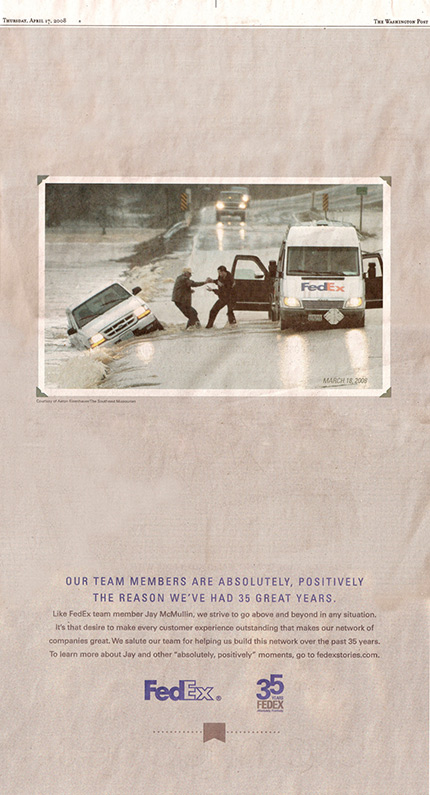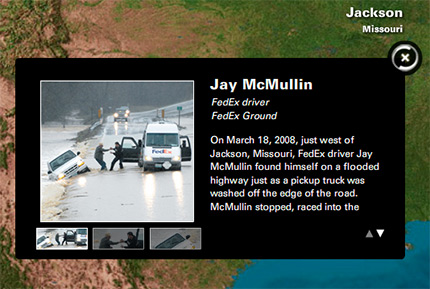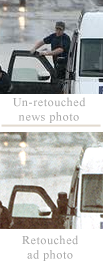The Value of a News Photograph
I can't tell you the number of times I hear from friends and colleagues that define themselves as "news photographers" that their images aren't worth that much, and re-use/licensing isn't a big deal to them.
Enter Aaron Eisenhauer (his blog), a staff photographer for the Southeast Missourian. Aaron was in the right place at the right time (from a news photographer's perspective anyway) to capture the rescue of a vehicle by a passerby, and a story about the rescue ensued. Next, the paper wrote about how the photo (and events) had received national attention. (check the link for other images from the incident). 
Guess who decided to turn this photo into an advertisement, after some retouching?
Why, FedEx. The photo appeared as the sole visual element in a full page ad that ran in the A section of the Washington Post yesterday. (click to see it larger in a new window).

The first thing that caught my eye was the photo credit - "Courtesy of" it read.

Could it be that the newspaper simply gave the photo to FedEx for free? The follow-up article notes "FedEx got permission from the Southeast Missourian to use the image on its internal employee Web site," but this is a national advertisement. Was it Aaron's to license himself? "FedEx is paying us for the photo. We didn’t just give it to them" wrote Aaron in an e-mail when we asked. Whew! FedEx, with their "Courtesy of" photo credit, which in newspaper parlance means "free", is usually used in relation to "Photo courtesy of the Jones Family", when no other art is available.
For Aaron, he's on staff there, so a resale really benefits his employer. Now, some employers have policies (either formal, or informal) where the staff shares in reprint or licensing sales, and Aaron's paper does as well. Aaron writes - " They paid $5,000 for one photo. They also paid $500 for the use of two hi res images from the sequence. Those two images were only used to create mock-ups of the ad, never to actually be used in the print ad. It was only to help them decide which photo they used. They still have the option, if they want, to buy the rest of the photos in the sequence for another $5,000. But for now, they are paying the Southeast Missourian a total of $5,500. I will get a share of this payment, but that percentage is still being discussed."
FedEx also used the image in a newsletter-type manner here, (which I would have expected), but then also on this external, much more commercial use on this FedExStories.com website, as seen, in part, here:

The next thing I wanted to know was if FedEx had gotten permission to use the photo of the man rescued. So, we placed a call, and spoke to the 78 year-old who's life was probably saved, Odell Bunch. "Oh yes", he said. "They came and got me to sign something." I asked if they were paying him anything, and he responded "oh, I don't know. I think they're going to send me something, I don't know, and I don't care."
I thought, perhaps that FedEx might buy him a new truck, so I asked. He said "no, the insurance paid for it. The engine was fine, just needed oil and fluids changed." So you're driving the same truck? "Yup" came the response.
I asked about what happened that day, and he was happy to recount the story. One point he made in the re-telling was that he knew his rescuer, Jay McMullin, saying "I know his folks, and he's a good kid, he would have stopped to help anybody." This didn't come out in the story, just that it was a FedEx driver who rescued Odell. Yes, saving someone is good. The FedEx ad leads us to believe that their employee just saved some random person, rather than someone that is a family friend.
 But I digress. this isn't just about FedEx paying Mr. Bunch, or not. Nor just about the fact that the guy that is standing in the background on his open car door's edge (the black doors open are the car behind the FedEx truck, not those of the FedEx truck), who was retouched out of the photograph (either because they couldn't find him, or they did, and he wouldn't sign a release), but it's about the value of your news photo - the one you think isn't worth much.
But I digress. this isn't just about FedEx paying Mr. Bunch, or not. Nor just about the fact that the guy that is standing in the background on his open car door's edge (the black doors open are the car behind the FedEx truck, not those of the FedEx truck), who was retouched out of the photograph (either because they couldn't find him, or they did, and he wouldn't sign a release), but it's about the value of your news photo - the one you think isn't worth much.Yesterday, Thursday, April 17, 2008, on page A16 (full page, above), the Washington Post's ad rate (as seen here) for 126 column inches, or 1 full page, runs $12,247.20 for one single day's media buy. With a license to use the photo forever, how many hundreds of thousands will they spend on advertising with just this one picture? Aaron also notes - "The full page ad also ran in USA Today and New York Times that I know of." Ok, so apparently the NYT's ad rate for a full page is $142,083 (as noted here). Maybe I got the ad rate wrong for the Post then? How could there be such a disparity between the Post and the Times? Oh, right, the Post sees itself as an educational company now! (Washington Post Company Now Skooling U, 11/24/07), And a full page in USA Today (as noted here) is $178,700.
Remember this the next time you say you don't care about re-use/re-sales of your "news" photos. Pictures are worth, yes, a thousand words, and this picture - over $5,000, the assignment, potentially $10,000+.This isn't a unique situation. I've seen ads using news photos for Hershey's, and the Red Cross, to name just a few. (heck, even a news photo of Eliot Spitzer ended up in an ad (see it here) from his State of the State address, but I'd doubt he signed any releases - but someone licensed that image for an ad!)
Please post your comments by clicking the link below. If you've got questions, please pose them in our Photo Business Forum Flickr Group Discussion Threads.

17 comments:
Very interesting read. Thanks.
"with a photo credit identifying it as being from the paper, is crediting the image to the paper a suggestion that it's an authentic news photo, when it's actually an altered/manipulated image, without the other driver in it? Does the paper know they're being identified as an authenticator of the image when it's not authentic?"
Excellent Post, John,I wonder what the contract read between FedEx and the newspaper. It seems like a one-way deal in favor of FedEx; maybe The Southeast Missourian should have added a few extra zeros to the invoice!
-Ken
This brings to mind three different similar events in my newspaper career:
1) Early 80's I was driving home from a haircut when I came upon a Ford Pinto in flames. It had been rear-ended and the gas tank ruptured. Just as I was pulling my cameras out of the car the other staff photographer from the paper, 30,000 daily, arrived and he was on duty. I turned the event over to him.
About six months later an attorney came calling. He represented the woman injured in the Pinto when it exploded in a suit against Ford. He purchased prints of every frame the shooter made. Ford found out and tried to buy all of the negatives but the paper said no. So Ford bought 20 copies of every negative. As the suit moved forward, other attorneys representing other injured clients, came calling.
When the dust had settled, the paper made nearly $50,000 in sales. Half went to the photographer.
2) I covered the 1995 US Army invasion of Haiti to restore President Aristide for The Washington Times. Fuji film purchased an image of a Haitian soldier beating a teenage boy on a bike. They used the image in a nationwide, year-long, promotion of their film. It was small brochure pullout pasted in to photo mags and had a different photographer for each of their films.
At first Fuji didn't want to pay for the image. Instead they offered film and mini-lab chemicals. In the end the paper settled for a bunch of film and $4000, of which I received half.
3) Same Haiti trip. I made an up close image of a Beretta 9 mm pistol being held by a US soldier with a crowd of Haitians in front of him. Beretta wanted to use the image in an ad and the paper said 'no'. Being a family newspaper they didn't feel it would be best for the paper. Never mind the fact the image ran on A1 4 columns.
Leave it to a newspaper to take advantage of both FedEx and the photographer. I say this because many "news photojournalists" get paid really poor wages and for the most part get taken advantage of by the publications the work for.
The stories that my friends tell me of major newspapers fighting with them over things as pitiful as milage reimbursement and decent health care benefits among other things is truly laughable.
But yet it looks like they have no trouble at all doctoring up an image for an advertisement and making sure that their lawyers sew up all of the rights and get paid the going rate.
"Photojournalists" take note.......you are getting used. Open your eyes, learn from this, because if you don't you are going to get taken again.
In honor of the Pope's visit to New York City I guess that you could sum this dilemma up like this: Photojournalists are to alter boys; as newspapers are to abusive priests.
Both should be avoided at all costs.
I agree with Mr. fink. His contention is the ultimate dilemma the paper has put itself in. How can the paper stand by the credit of an image that has been manipulated?
I know they've used this shot in more places as well. I don't recall for sure, But I think it was used in the LA Times too. FedEx is certainly getting some mileage out of that $5500.
Call me cynical but amazing how this came out just days before the NY Times runs a highly critical piece of the way FedEx treats its contract workers..
anonymous said...
Call me cynical but amazing how this came out just days before the NY Times runs a highly critical piece of the way FedEx treats its contract workers..
Maybe they should look in their own backyard before they throw stones at others. The NYT treats their freelancers like slaves.
the new york times treats their freelancers like slaves?
HA ! slaves were treated BETTER, at least the "bossman" would provide a roof and food for doing work.
The Times only gives you a byline and a "you should be happy you shoot for the times" attitude.
very good article. just nitpicking the fedex van door is open is a rear sliding door.
Thanks for sharing this story. When more of these stories are told it will help photographers understand what their photo could be worth.
thanks,
Stanley Leary
www.StanleyLeary.com
Bravo for pointing out things that no one wants to see or hear!
It's hard to hear tone when it's written, however I get a feeling that the paper and photographer almost don't care how much he earned from the photo.
Our industry is plagued with apathy and it is apparent in the verbiage and pricing of so many photographers.
Please keep bringing us the info no one wants to face.
From this web site: http://www.goiam.org/content.cfm?cID=6615
"The IRS recently ordered FedEx to pay back taxes and fines totaling nearly $320 million to ground employees who were improperly classified as independent contractors."
FedEx appears to “misclassify its FedEx Ground drivers as ‘independent contractors’ to get around civil rights and labor laws. The report uses worker interviews and cases filed against FedEx how the company is “circumventing federal anti-discrimination laws, avoiding payment of millions of dollars in benefits to 15,000 FedEx Ground drivers and hindering workers’ rights to form unions.”
Hey John I remember back in the early 90's having Kodak send me some sample film they wanted to try out. I shot a murder scene in DC with the film on New Year's Eve and Kodak ending up paying me I belive it was either $2500.or $5000. for using the picture in a National ad for Kodak's new high speed color slide film. The picture also ran in the Washington Times as a news pic. and they paid I belive $100.00 for a freelance shot back then.Mark Reinstein
花蓮入口網|花蓮|花蓮民宿|花蓮民宿訂房諮詢服務|花蓮美食|花蓮民宿|花蓮旅遊|花蓮|花蓮電影|花蓮|花蓮民宿|花蓮海洋公園|花蓮縣長|花蓮遠來飯店|花蓮提拉米蘇|花蓮客運|蜂蜜|花蓮太魯閣|花蓮廣告|花蓮地圖|花蓮旅遊|花蓮民宿|花蓮房屋|花蓮民宿|花蓮汽車|花蓮餐廳|花蓮旅館|花蓮瑞穗牧場|花蓮名產|花蓮民宿|花蓮租屋|花蓮理想大地|花蓮民宿|花蓮廣告|花蓮黃頁 網路電話簿|花蓮民宿|花蓮計程車|花蓮餐廳|花蓮租車旅遊網|花蓮入口網 IN HUALIEN 吃喝玩樂樣樣通|花蓮旅遊|花蓮|花蓮|花蓮|花蓮|花蓮|花蓮
Post a Comment